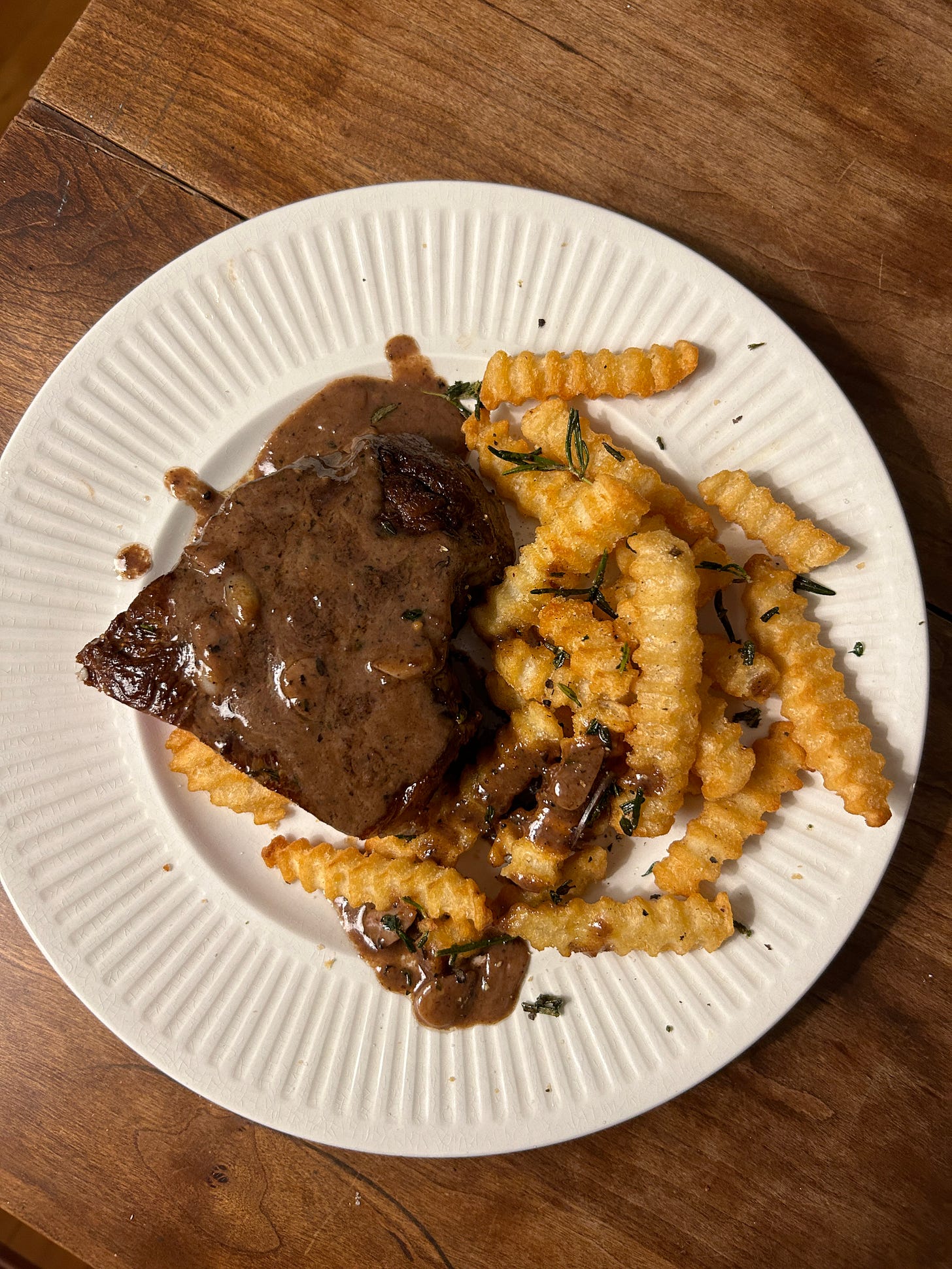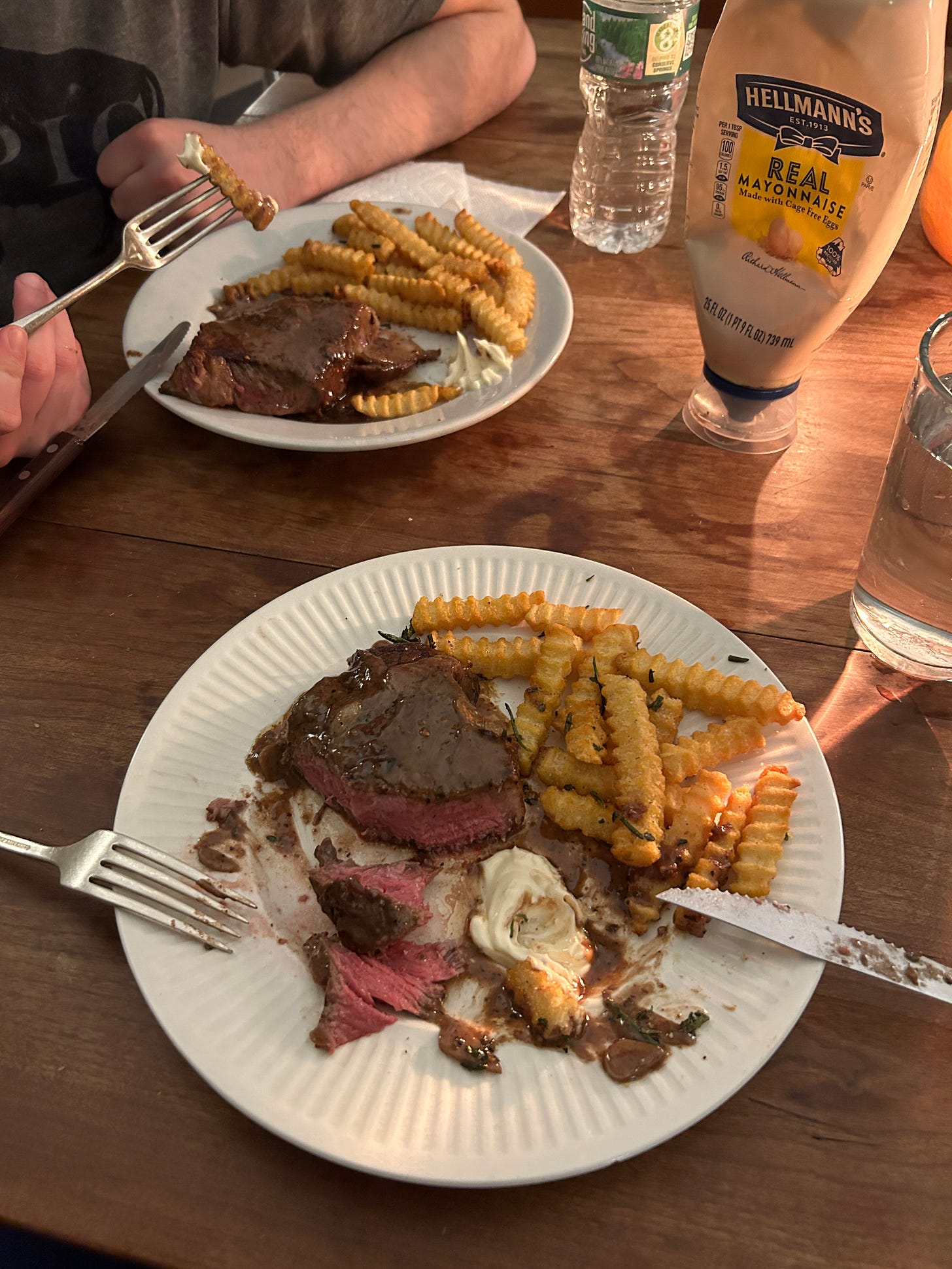Last night’s dinner was a meal that I could eat many, many nights in a row: steak frites.
I don’t speak French, but I have to imagine “steak frites” literally translates to “steak fries,” and this dish is neither the thickly cut style of fry called “steak fries,” nor a slab of steak cut into fry-like batons, a la Burger King’s chicken fries (“poulette frites”).
No, I can bet this bistro classic’s name is a derivative of the longer version “steak con frites” - shortened so that it can be ordered in less time and eaten that much sooner, it’s so damn delicious.
Soft, juicy steak against the crisp crunch of a hot fry that has gone soggy in one corner from a deliberate dousing of sauce. Mmugh!! That was the noise I made when I ate it.
I just did some reading about what kind of steak typically/historically goes on the plate. There’s no sure answer (after 4 minutes of googling). Just use a steak you like. I got a NY strip from whole foods. It wasn’t the most interesting, but it got the job done. I didn’t want anything with a lot of fat (ribeye), even though it’s my overall favorite. I would have liked something like a filet, but damn those bastards for knowing that they can overcharge for what everyone thinks of as “a fancy steak.” I’ve since done some reading about something called a “bistro steak” (also known as shoulder tender, petite tender, beef shoulder petite roast, bistro tender, or bistro filet apparently, like wtf why does every cut have to have 6 names) - and that seems to be a winner! Ask your whole-animal butcher next time you swing by, because I know everyone has one.
One time I was waiting at the whole foods butcher counter behind a woman who got a NY strip. Making small talk, the butcher asked what she was planning to do with it. He was slightly disturbed when he thought she said “put it in a soup” (it was $22/lb) but she had actually said “eat it with soup.” Which was less concerning but no less curious (now I’m trying to think of meals that require 3 utensils).
Anyway, I started the steak on the fat cap side in a cold pan, letting it sort of render as the pan heat up. I’m kind of over waiting for a pan to get ripping hot when I’m cooking meat. Vegetables, usually yes (but sometimes no!). But putting a thick steak or a chicken breast in a cold pan is kind of like a reverse sear, except by the time you flip it to cook the other side, the pan is really hot, so it’s not a perfect system but I’m hover-y enough and cook intuitively anyway, it all turns out fine (attempt at humble bragging - was it good?).
Once the steak was nearly done, I did that cheffy thing with the butter and the garlic clove and the herbs (rosemary and thyme from a mixed bunch I bought at the farmers market in mid-December and it’s STILL GOING STRONG). I removed the crispy herbs, and had sliced the garlic so it could actually be part of the pan sauce, which I made from a little bit of red wine that I’ve had for so long I’m pretty sure it’s rancid but I can’t fully tell when I cook with it, some worcestershire sauce, a spoon of beef broth concentrate, some water, a bit of heavy cream, and lots of black pepper. I laid all these things out before I started to build the sauce, because in a wide, shallow pan it all evaporates fast and you want to move quickly before it distills too much.
John had the extremely important task of babysitting the frozen Ore Ida fries in the air fryer. In spite of its difficulty, he handled it with grace. Once they were done, I tossed them in a bowl with salt and a tiny pinch of sugar (trust me), and then sprinkled them with some of those frizzled herbs, god I’m so gourmet. Don’t forget the giant plop of mayo!
Dinner was nearly silent except for a comment from me about how the sauce was slightly salty. We were exhausted from the day’s activities of walking a lot and going to the MoMA, aka a completely normal Saturday pre-2020.
Dessert was a ferrero rocher in bed, followed by a second one that John generously retrieved for me when he got up to get himself a glass of water.






